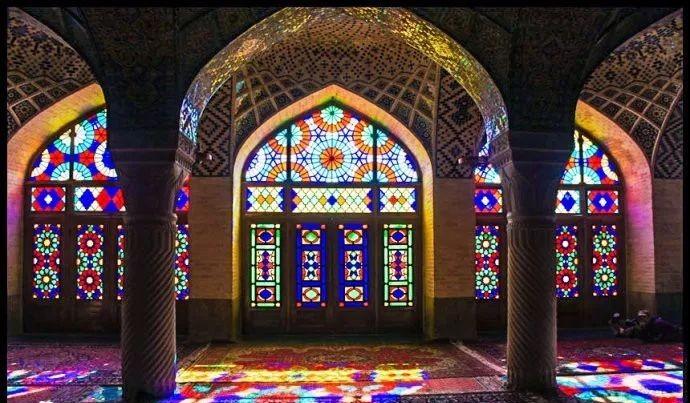Azadi Tower
The 'bell-bottoms' of the Persian Empire, incorporating traditional Iranian features into a modern 1960s style. The tower is three meters high and 50 meters above ground level. The ground floor houses the Quran Museum and a cinema. There are elevators and stairs leading to the top of the tower, offering a panoramic view of the city. Passing through the bell-bottom-like Iranian gate signifies entering Iran.
Golestan Palace
This place used to be the center of Tehran, witnessing the glory and extravagance of the Qajar rulers. 'Golestan' means 'rose garden' in Persian, hence it is also known as the 'Rose Palace'. It consists of several exquisite buildings, among which the Talar-e Berelian, built by Naser al-Din Shah, is the essence of the entire palace complex. The dome and walls are inlaid with various mirrors, creating a stunning visual effect.
National Jewels Museum of Iran
Located within the Central Bank of Iran, it can only be accessed through a hidden door leading underground, making it the most expensive basement in the world. There are over 40 display cases here, showcasing the most precious national treasures of the Iranian royal family over the centuries. These include jewels, ornaments, weapons, thrones, crowns, and court attire. The highlight of the collection is a 34-kilogram jeweled globe, with a frame and base made of pure gold, encrusted with 51,366 rubies and sapphires. The treasures housed in this museum surpass those of many other national museums.
Tehran Grand Bazaar
Tehran Grand Bazaar is one of the largest and oldest bazaars in the Middle East. Entering through mosque-like arches, the interior is entirely built with stone, featuring 'arched dome' streets that are interconnected with domed arches. The shops on both sides are filled with a wide variety of goods, from cheap items from China to valuable local handmade carpets. Additionally, there are public facilities near the bazaar, such as mosques, baths, and restaurants. You can shop at the bazaar, perform prayers, take a hot bath, and then enjoy a delicious meal, deeply experiencing the customs and traditional culture of Persia.
Pink Mosque Masjed-e Nasir
The Nasir al-Mulk Mosque, also known as the Pink Mosque, is often referred to as 'the most beautiful mosque in Iran.' The mosque's entrance is adorned with exquisite copper patterns. The most awe-inspiring feature is the magical color effect created by the morning sunlight. The light passes through the stained glass windows, casting vibrant colors onto the hall and the equally colorful and intricately patterned carpets, forming a perfect combination of patterns and light.
Tomb of Hafez
Experience the poetic and wine-loving culture of medieval Persia. Hafez and Saadi are the pride of Iranian culture and are two world-renowned poets. Saadi's tomb is located in the northeast of Shiraz, designed with simplicity and brightness, and is a building with Iranian characteristics, making it a perfect place to spend an afternoon. Hafez's tomb is seven kilometers away from Saadi's tomb, a ten-minute taxi ride. Hafez's tomb is a building with a slightly modern minimalist style, where you can see many Iranians devoutly kissing the tombstone and reciting loudly beside it, allowing you to deeply feel the poetic nature of this country.
The ruins of Persepolis are located northeast of Shiraz. This site was a summer palace built by the Achaemenid dynasty of the Persian Empire. Darius and his descendants held grand ceremonies here every New Year, receiving tributes and homage from envoys of various nations. Eventually, Alexander the Great conquered Persia and set fire to this magnificent palace, reducing it to ruins. It is like an open-air museum, allowing future generations to faintly glimpse its former glory.
Imam Mosque (Masjed-e Shah)
The Imam Mosque is known as 'the most beautiful mosque in the world'. This mosque extensively uses blue mosaic patterns, combined with the proportionate architecture of the Safavid period, creating a perfect visual spectacle. There is a mark made of black stones on the ground directly facing the dome, known as the 'Echo Stone'. Due to the seven-level echo effect of the dome, clapping or shouting underneath it will produce a repeating echo.
Chehel Sotun Palace
Chehel Sotun Palace, located in the King's Garden, was built by Abbas and served as an annex to the King's Square at that time. In front of the palace, there is a 110-meter-long pool surrounded by fountains and stone carvings. The grand and magnificent porch is supported by 20 plane tree columns, which are reflected in the pool, making it appear as if there are 40 columns. The garden inside the palace is an outstanding example of a Persian garden and is also listed as a UNESCO World Heritage Site.
Vank Cathedral (Kelisa-ye Vank)
The southern district of Isfahan is a settlement area for Armenian Christians, and Vank Cathedral is a significant focal point in the history of the Armenian Church in Iran. The exterior of the church is unassuming, but the interior is lavishly decorated, incorporating multiple styles—a hodgepodge of Islamic tiles and designs as well as Christian imagery.
Si-o-Seh Bridge
Here you can immerse yourself in the most authentic Iranian lifestyle. The Si-o-Seh Bridge was built during the Abbas period and lies across the river bend, with many Islamic-style arched doors on both sides. In addition to transportation, it also serves functions such as damming, water conveyance, banqueting, cooling, and watching performances. It is a model of bridge construction from the Safavid period.

























